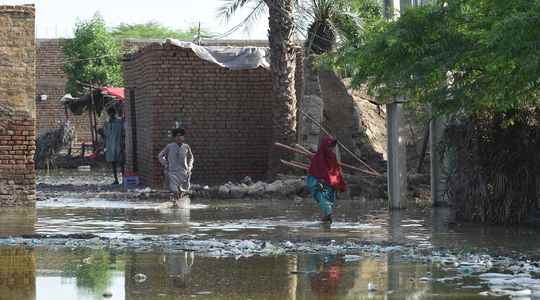In the steep valleys and on the tops of the mountains, the streams and the rivers overflow and carry their share of disasters. In Pakistan, the rainy season favorable to harvests, which traditionally extends from June to September, makes the country experience very difficult days. In just a few weeks, 1,061 people – a still temporary toll – lost their lives in the floods that ravaged a large part of the territory. In the North, muddy torrents cross the villages, carrying away cars and houses. To the south, the plains are waterlogged. The bad weather spread over thousands of kilometers along the Indus, a river that cuts Pakistan in two.
The floods are “like an ocean, there is water everywhere,” said Prime Minister Shehbaz Sharif, who is touring hard-hit areas in the north to lead relief operations. An “unprecedented” disaster, he also commented.
Nearly a million houses were destroyed or seriously damaged, 80,000 hectares of arable land were ravaged, more than 3,400 kilometers of roads and 157 bridges were washed away. On Sunday, the government declared a state of emergency and called for help from the international community. The army was even mobilized to contain this “disaster of a rare magnitude”, in the words of the Minister of Climate Change, Sherry Rehman.
Dangerous evacuations
Torrential rains fall day after day and cause landslides. The day before, thousands of Pakistanis had been evacuated, in particular in the province of Khyber Pakhtunkhwa, in the north-west of the country. In the south of the country, Sind, one of the four federated provinces of Pakistan sheltering the economic capital Karachi, is partly under water. Before seizing the capital, the water should reach the city of Sukkur. The inhabitants took refuge on the elevated roads and on the railroads. Tents have been erected over two kilometers to accommodate the victims who continue to arrive by boat, laden with wooden beds and crockery, the only goods they have been able to save.
The difficult access to remote villages makes evacuation operations perilous and time-consuming. With the infrastructures, in particular aerial ones, out of service, the emergency services are suffering. “There is no landing zone or approach available (…) It is difficult for our pilots to land,” a military official told AFP, on condition of anonymity. The relief of the massifs where high mountains and deep valleys are the norm also makes overflight difficult. These devastating bad weather are reminiscent of another episode of flooding in Pakistan. In 2010, similar torrential rains killed at least 2,000 people, affected 21 million people and deprived 10 million people of their homes.
Bloodless economy
Above all, the floods had seized the country’s economy. The damage, estimated at around 43 billion dollars, has had a lasting impact on public accounts since it represents the equivalent of two years of GDP. The Pakistani economy, still in bad shape today, is seeing its currency unscrew and galloping inflation (44% last week). Before bad weather disrupted Pakistani society, its political class was negotiating a rescue plan with the IMF.
International aid is therefore being put in place to assist this demographic giant of South Asia. On Sunday, the first flights bringing humanitarian aid arrived, from Turkey or the United Arab Emirates. The UK expressed support for remittances. French President Emmanuel Macron has promised “to help”.
Welcome assistance as the country prepares to experience similar episodes, Pakistan being one of the most vulnerable countries to climate change. It is ranked eighth among the countries most at risk from extreme weather events, according to a study by the NGO Germanwatch.
